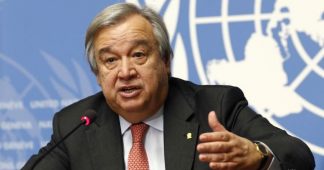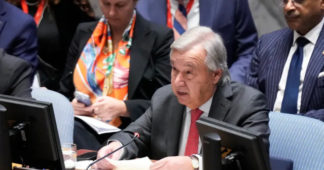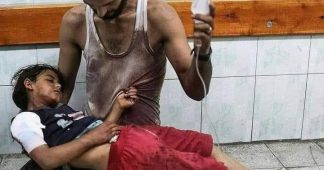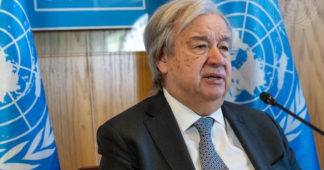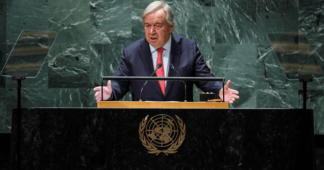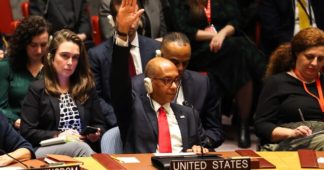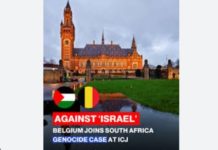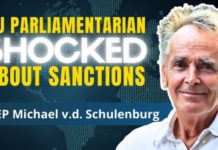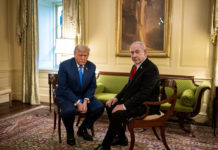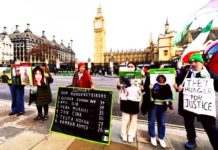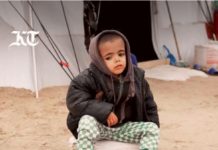By Anuradha Chenoy*
There are different levels and kinds of opposition to Israel’s systematic massacres of Palestinian people in Gaza conducted in the name of retribution for the October 7 attacks by the Hamas, indicating the positions but also revealing the helplessness of various communities and countries, on account of Israel’s determination to defy all pressure, go ahead with their ethnic cleansing of Gaza and the support they receive from the US.
The moral and ethical opposition at the highest level comes from the Security Council, the United Nations General Assembly, and other UN bodies. The US veto of a Security Council Resolution that proposed a humanitarian ceasefire (December 8, 2023) was not surprising even though heartbreaking This veto pitted the US directly against the United Nations, because the rare Article 99 of the UN Charter that allows the secretary general to bring up an issue that threatens international peace was used.
Secretary General Guterres in his impassioned remarks stated ‘there is a high risk of the total collapse of the humanitarian support system that would result in devastating consequences, possibility of mass displacement and conflict overflow into the region.’ Guterres reported that 130 UN staff had been killed, more than 17000 civilians killed- with over 4000 children; Israel has targeted 339 education institutes, 26 hospitals, 88 mosques, 3 churches, 300,000 homes are destroyed; 85% are homeless “nowhere in Gaza is safe.” Conditions are unsanitary and there is a “serious risk of starvation and famine.” (United Nations, December 8, 2023) These figures only increase by the day.
In addition the risk of disease and complete lack of medical care and devastation is everywhere. Guterres’ words have been echoed by many other UN bodies like the World Health Organization and the UNICEF which stated “This is a war on children” as an unprecedented number of children killed with indiscriminate bombing- more than any other conflict. Conditions on the ground are unsafe and unlivable with no access to water or toilets. Same number of children are dying from the sky and from deaths from the ground.( (James Elder, UNICEF, 15 December, 2023) So this is the highest level of humanitarian disaster.
Similarly, (non-binding) resolutions for humanitarian ceasefire were overwhelmingly passed by the UN General Assembly on December 12 and earlier on 24 October, both times opposed by the US, Israel and few allies. Here again Guterres condemned Hamas, but contextualized that the Palestinian people “have been subject to 56 years of suffocating occupation”. He expressed concerns about “clear violations of international humanitarian law that we are witnessing in Gaza”. (UN, October 24, 2023)
The US in its hubris has chosen to bypass the appeals of the international community that it tried to solicit support for the Ukraine war. The UN has thus repeatedly stated that there is clear evidence that war crimes have been committed, that “Laws of Armed Conflict” that include international humanitarian law have been violated.
Regional Positions and Pressure Points
The Arab states are under pressure from the mass outrage on the Arab streets. Their meetings with Blinken and the Joint meeting of 22 members of the Arab League and the 57 member Organization of Islamic States (11/11/23) shows bloc unity and resistance against US pressure, signifying a paradigm shift in this region.
The Arab leaders are pointing to Israel’s actions as violations of international humanitarian law, human rights, collective punishment and they charge Israel with war crimes in Gaza. They speak of Western hypocrisy and double standards that provides Israel with full impunity. Israel’s laws discriminate against its Palestinian citizens.
The collective of the Arab and Islamic states agree on: complete cease fire; humanitarian access; no displacement that will push Palestinian refugees across the border; a viable two state solution; de-escalation to prevent regional conflagration. They have however put no teeth to alleviate the plight of Gaza. They disagree on taking concrete actions like applying sanctions on oil supplies, closing the Suez for traffic, or declaring a no fly zone, which could cripple and put immediate pressure on Israel.
This region holds 48% of global oil reserves and 30% of global container traffic passes through the Suez Canal. But the autocratic regimes hostile towards each other, have made it ideal for external interventions. The US exercises influence and has strategic partnerships including with Saudi Arabia, Egypt, Jordan and military bases in Turkey (NATO member), Kuwait, Bahrain, Qatar, Jordan, UAE, Oman. Now, the US has sent naval fleets and nuclear submarines into the Eastern Mediterranean to project power and threat. So the one big step is that these states are sitting together and talking of Palestine.
The ‘Axis of Resistance’
A different position is taken by the so called the ‘Axis of Resistance’. Here, Iran as a regional power is antagonistic to the US and strongly supports Palestine’s resistance. The US blames Iran as the main supporter of Hamas, the Lebanese militia- the Hezbollah and other regional militia in Iraq, Syria and Yemen. US Secretary of State Antony Blinken has repeatedly warned Iran not provoke Israel. Iran has said there would be resistance against Israel’s ground operations in Gaza.
However, Iran’s supreme leader Ayatollah Ali Khamenei has shown restraint and told the head of Hamas that Iran was not informed of this operation and would not intervene directly. Interestingly Hezbollah leader Hassan Nasrallah similarly said that ‘resistance against Israel’ is led by Hamas alone, and will remain so. That Hezbollah ‘distracts’ the IDF on Israel’s North so as to decrease the pressure on Hamas, but “all options are open”. So, Hezbollah carries out attacks on Israel’s northern borders and seeks to protect Lebanon. These strikes are becoming a small war in South Lebanon with Israel is regularly bombing Lebanon’s border villages.
In Syria, the US intervened and has been trying to change the Bashar al-Assad government since 2011. The US occupies the oil rich northern part of Syrian, as former US President Donald Trump declared: “We’re keeping the oil’’ in Syria (ABC News, October 29, 2019). Russian support has assisted the Syrian regime survival.
Yemen is caught in a civil war where the Houthi minorities are supported by Iran while northern Yemen is supported by the Saudis. Yemen is the poorest in the region and the Ansarullah Government has allowed attacks on ships purportedly linked to Israel in the Red Sea, making this shipping lane dangerous for Israel, who threatens war against Yemen.
All these post-US intervention states with severe economic and political crises, have various stray armed militias that seek revenge against the US and are seen as linked to Iran. The strongest is Hezbollah that had a 34 day war with Israel in 2006. These militias engage in pin prick targeting of US bases in the region (reaching a hundred since this conflict began) and they face US bombing in retaliation. In sum, US bipartisan chorus believes that bombing Iran and going after these militias by random bombings will quell opposition in the region. The Global Majority is concerned about this regional conflagration.
Russians and Chinese in the West Asian Theatre
The Russians have been engaged with Israel and Palestinian leaderships, support the two state solution, have strong links with Iran, support the Assad regime in Syria, are part of OPEC+, negotiate deals with Turkey. The Chinese mediation in March 2023 brought the Saudis and Iran together after 7 years of hostility. China’s material basis comes from its: Belt and Road Initiative involving 19 West Asian countries with infrastructure building; are amongst the biggest buyers of Gulf oil; are furthering trade in yuan and national currencies; have a 25-year strategic cooperation with Iran. The Russians and Chinese appear to coordinate in the region and oppose any external intervention in Iran’s internal affairs. Further BRICS expansion includes Iran, Egypt, Ethiopia, Saudi Arabia and UAE. And Iran is part of the Shanghai Cooperation Organization. This increases the stability and leverage of this loose bloc in this region. The Arab Bloc is expressing desires for closer cooperation with Russia and China. The geopolitics of these moves are that it decrease the vulnerability of these states to the Israel-US axis. The Russian Chinese presence signifies a shift in West Asian geopolitics, increase possibilities for strategic autonomy and opportunity of manoeuvre– easing US pressure on West Asian nations. But people of Gaza remain increasingly vulnerable to the continuing massacre that resembles ethnic cleansing.
The Global South and the Global Solidarity Street
In its own uncoordinated ways the Global South has called for ceasefire, humanitarian assistance and supports a negotiated two state solution for Palestine. Several countries like South Africa, Honduras, Columbia, Chile, Turkey, Bahrain, Jordan have recalled their ambassadors from Israel. Others like India, balance between Israel and Palestine, reiterating a two- state solution.
The strongest moral pressure for Palestine comes from the global solidarity street. This street is a combination of organic intellectuals, truth seeking analysts, alternate media persons, creative users of social media, bloggers, who have formed virtual connecting points globally. The mass and highly protests in the West, South and east are calling for a free Palestine. Importantly, they have cracked into the Western hegemonic mainstream media.
These global solidarity street’s protests conveys three messages based on reports from the UN, analysts and legal scholars, independent ground reporters and such:
- Contextualise: This means reject the discourse that restricts the crises only to the terror attacks of 7/10 and its aftermath. Instead contextualise the responses to historical oppressions going back to the foundation of the Israeli colonial settler state. The structure of apartheid and laws based on race. But especially the siege of Gaza/Palestine the last 17 years.
- Humanise: Whereby they have use images and stories from Gaza to humanise the Palestinian people, separate them from terrorist actions, while hegemonic discourse seeks to de-humanise the Palestinian/ Arab people and conflate them all as terrorists and expendable.
- Naming: Using the politics of naming as opposed to politics of denial. This global solidarity bloc has taken the reports from the UN Human Rights Council and human rights bodies, legal scholars to name Israeli system and Palestine’s status as an ongoing ‘Nakba’ of catastrophe. They quote UN Secretary General who says Gaza is a ‘graveyard of children’, and cite scholars who call this “a textbook case of genocide”. They show up the structure of Israeli laws that distinguish between Israeli versus the Palestinian race as apartheid.
Legal debates will continue and histories re-written, but politicians know that the vote of such masses on the streets counts.
US
The US interest in backing Israel are evident in President Biden’s word: “If Israel didn’t exist, we would have to invent it” (October 18, 2023), backed by his words that he is a Zionist. Israel is US’s proxy in West Asia, it’s reliable military forward base in this hydrocarbon rich and strategic region. So the US has committed a $14.5 billion military aid package to cover this war, besides US dozens of bases and military is on alert for the co-management of this region.
The real issue is about Palestine, but hegemonic discourse seeks to make it about Israel by centring antisemitism, which can always be questioned appropriately. Philosopher Judith Butler argues in Boston Review, December 13,2023, that US campuses are being censored and this ‘allows the slaughter of Palestinians to continue; it also serves as a mirror for the justification for state violence.’ The Israel-US axis are attempting to deny Palestine and cancel its defenders of its rights.
Conclusion
The catastrophe (Nakba) of Palestine and the geopolitics around it continue. The current massacre in Gaza and of Palestine has brought the Palestine question into global consciousness. The reason for hope are the indefatigable Palestinian people and their resolve for freedom. But they need support. The changing geopolitical environment of multipolarity and the possibility for independent diplomacy provides an opening. The credibility of liberal internationalism, human rights, and the idea of a rule based order are at stake and if they cold storage the Palestine question again they will have little credibility left.
The geopolitics of West Asia in conjunction with China and Russia have significantly shifted. The joint uncoordinated forces of the global solidarity street, multipolar geopolitics that challenge hegemony, and regional diplomacy may see a push for a process of succour for the Palestinian people. But there is currently no real humanitarian redressal for the Palestinian people. And too little where much more is needed.
*I am grateful for the webinars of the Transnational Institute, that helped me formulate some arguments.
(Anuradha Chenoy is Associate Fellow of the Transnational Institute and Adjunct Professor at the Jindal Global University, Haryana, India).
* Anuradha Chenoy, Adjunct Professor, Jindal Global University.
We remind our readers that publication of articles on our site does not mean that we agree with what is written. Our policy is to publish anything which we consider of interest, so as to assist our readers in forming their opinions. Sometimes we even publish articles with which we totally disagree, since we believe it is important for our readers to be informed on as wide a spectrum of views as possible.
